30 Large Dog Breeds That Make The Best Pets
Read up on large dog breeds and what it takes to keep them happy.
Read up on large dog breeds and what it takes to keep them happy.
by Kelly Villa, | May 13, 2024

Julie Meme / Stocksy
When it comes to finding the perfect dog, size does matter. While tiny dogs have their appeal, big dogs bring unique qualities to the table, like offering a feeling of security, the athleticism to go on long runs with you, and plenty of love and loyalty.
To be considered “large” and in charge, a dog breed has to weigh between 50 and 100 pounds as an adult. Large breeds typically stand at least 22 inches tall at the shoulder, but that varies depending on each breed’s average.
A lot of large breeds come from a line of working dogs, which is why their strength and girth are so important. They have the muscle to do a job, the determination to see it through, and the imposing stature to intimidate anyone who doubts them (or who tries to steal your sheep). But that doesn’t mean these dogs don’t love a good cuddle session. Despite their size, many of these large dogs are incredibly affectionate and enjoy being close to their pet parents, and even consider themselves lap-dogs.
If you’re considering adopting a new dog, here is a highlight some of the best large-breed options for families and individuals looking to add a new member to their pack. And if big pups aren’t for you, try these small dog breeds instead.

Edgardo Mota / Wirestock / AdobeStock
The Akita originated in Japan and typically weighs up to 130 pounds. The giant-breed dog is quite sturdy and muscular, with a thick double coat that comes in many shades, but most frequently is white, brindle, and red. Akitas are particularly known for their loyalty and devotion to their families — strangers are not their favorite, nor are other pets.
That said, they are also independent and smart, so they require consistent training to be at their best. Most Akitas will be comfortable with their “pack” and kids they know from a young age. Akitas like to play and go for walks, but are not marathon runners. If they’re getting the care they need, there’s no need to run them for hours outside.
Height: 24 to 28 inches
Weight: 60 to 121 pounds
Browse for Akitas (and their mixes) for adoption

Demetr White / Stocksy
The Doberman Pinscher first became popular in Germany in the late 19th century. These giant-breed dogs typically weigh between 75 and 100 pounds and have a distinctive, sleek, muscular build and a short but silky coat. Aerodynamic is the word that comes to mind when you see a Doberman.
Dobermans are associated with the negative stereotype of being tough watchdogs and protectors, but these big dogs can actually be pretty dopey. Dobermans need to feel secure with their people and have good, early socialization and training to be comfortable with strangers.
Height: 24 to 28 inches
Weight: 60 to 117 pounds
Browse for Doberman Pinschers (and their mixes) for adoption

VioletaStoimenova / iStock
Everyone knows the Old English Sheepdog’s shaggy coat and adorable face, probably from some version of Peter Pan in which one of these gentle giants was the “nanny dog” for a group of rowdy kids. They grow to be about 100 pounds, but that’s 100 pounds of total sweetheart.
Though sheepdogs are easy to train, they can be playfully stubborn, probably because they’re also so smart. Expect some barking because these large-breed dogs are alert to intruders. Old English Sheepdogs are not high-energy dogs, but they need regular walks and play as well as a healthy diet, or they might get a bit chunky. It can be hard to tell when that happens, though, because of their thick, long coat. Brush them so you can tell the difference!
Height: 22 to 25 inches
Weight: 57 to 100 pounds
Browse for Old English Sheepdogs (and their mixes) for adoption

MOAimage / Shutterstock
Collies are on the smaller side of larger dogs, coming in at around 75 pounds at their biggest, but as proud working dogs, they pack a lot of power. They were bred to herd sheep, so expect to have them at your heels at all times.
Collies are great family dogs — good with children and other animals. Their favorite thing is getting told what to do, so they’re extremely trainable and love games. Make sure your Collie gets regular exercise and lots of mental stimulation if you don’t have a herd of sheep for them to boss around.
Height: 20 to 24 inches
Weight: 44 to 79 pounds
Browse for Collies (and their mixes) for adoption

PROMA1 / Shutterstock
Airedale Terriers were originally bred in England as hunting dogs for small game and rats. Yum. They’re big muscular dogs and have wiry, dense coats that are typically tan with black markings. Airedale Terriers are quite friendly, with outgoing personalities. They’re considered great family dogs and like children.
As hunters, they like agility tests and other tasks that allow them to sniff, chase, track, and show off all their skills. They are definitely high-energy and need to get in those walks, runs, and some playing in the yard for optimal mental health.
Height: 22 to 24 inches
Weight: 36 to 67 pounds
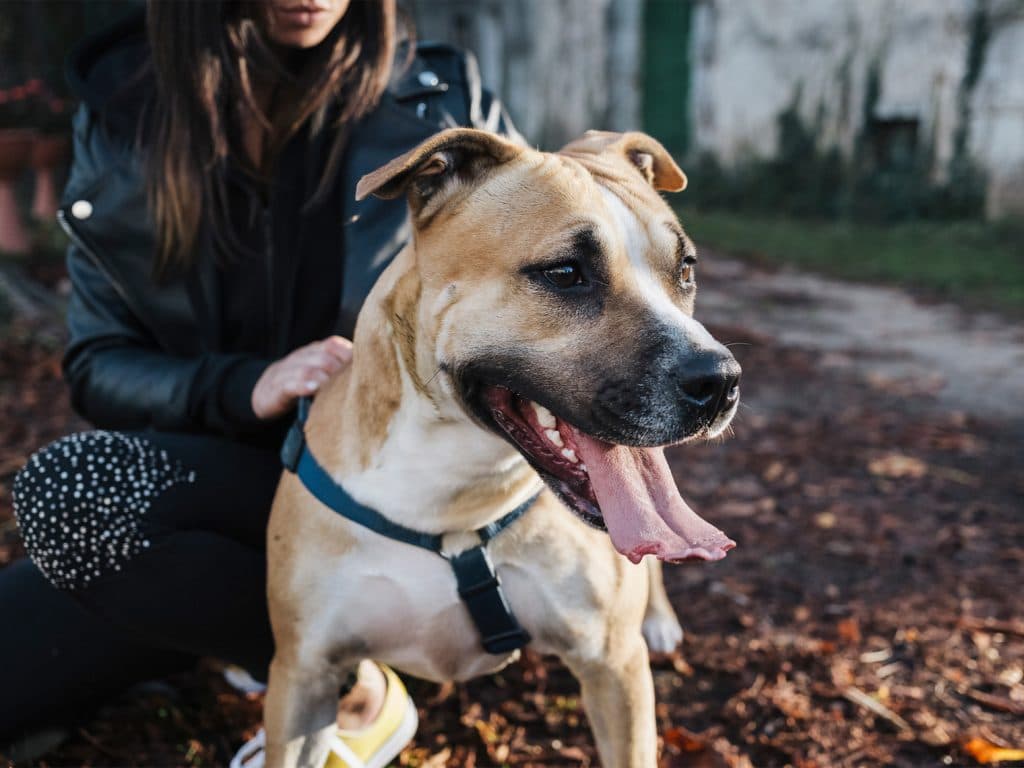
Mauro Grigollo / Stocksy
Like many terriers, the American Staffordshire Terrier, sometimes called the “AmStaff,” was bred to work, but theirs was a nasty job: bull-baiting and dog fighting. Of course, these large-breed dogs are naturally very strong and athletic. They have a strong prey drive, but are also smart and eager to please.
These dogs are truly people-oriented companions who like kids but need early socialization and training when introduced to other small pets. AmStaffs also need a lot of activity and daily exercise and are happiest in homes with yards or access to outdoor space. They do have a short easy-to-maintain coat, so that’s a plus.
Height: 17 to 19 inches
Weight: 38 to 68 pounds
Browse for American Staffordshire Terriers (and their mixes) for adoption

Grisha Bruev / Shutterstock
The Giant Schnauzer, originally from Germany, was bred to be a livestock guardian, and they have been known to herd a lamb or two. They grow thick, rough coats and weigh in at around 85 pounds.
They’re very protective and loyal and will bark whenever they perceive a potential threat, which is often. These big dogs need a lot of daily exercise and are great with agility tasks, so don’t keep them shut inside all day. They once roamed the fields and would love to do so again at any opportunity.
Height: 23 to 27 inches
Weight: 59 to 97 pounds

Bo Bo / Stocksy
The Alaskan Malamute was bred for working hard in the cold, hauling heavy freight and sleds in the arctic regions. They’re super strong and have a dense coat to keep them warm, so they prefer a cooler climate.
Malamutes make excellent companions for those looking for a large-breed dog. They’re outgoing and affectionate and have a tendency to howl like a Husky when trying to communicate. That means apartment living is probably not the best choice for a Malamute, at least if you don’t want to be hated by your neighbors, but they are good guard dogs for more remote properties.
Height: 23 to 28 inches
Weight: 61 to 105 pounds

Lucas Ottone / Stocksy
The Greyhound is a tall, noodle-like dog bred for hunting and racing, with a lean and athletic build and a short, smooth coat. Despite their great speed, Greyhounds are known for having chill demeanors, which makes them bad guard dogs; they tend to be avoidant rather than confrontational around strangers. Greyhounds make great family dogs for those looking for a large canine, however.
Though they obviously have the capacity for bursts of energy, and moderate walks and runs are important for their health, Greyhounds love lounging on the couch with you and sleeping whenever they can.
Height: 27 to 30 inches
Weight: 54 to 83 pounds
Browse for Greyhounds (and their mixes) for adoption
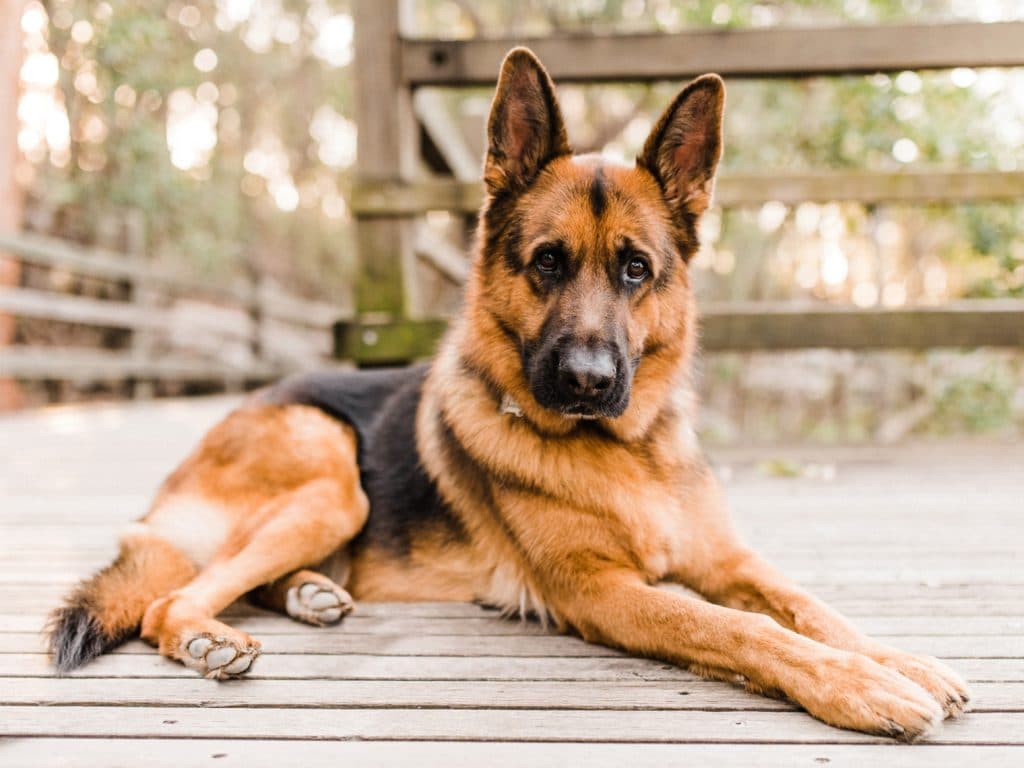
Samantha Gehrmann / Stocksy
The German Shepherd is a well-known breed often associated with law enforcement in the United States. However, these large dogs were originally bred for the gentler occupation of guarding herds of sheep. These loyal large-breed dogs weigh up to 90 pounds on average.
While they are quite strong and visually intimidating, they can also be very loving, loyal, and affectionate with their pet parents. They tend to be protective (duh) and wary of strangers, so careful socialization is a must. They need long walks and play and are great at tasks that challenge their skills with agility, tracking, and sports. Don’t forget plenty of one-on-one grooming time; those coats are thick and shed a lot.
Height: 22 to 26 inches
Weight: 48 to 97 pounds
Browse for German Shepherd Dogs (and their mixes) for adoption

Andriy Bezuglov / Stocksy
The Boxer is an athletic, working breed that weighs between 50 and 70 pounds and sports a short, smooth coat. They have energetic personalities and like children and other pets if introduced to them respectfully.
Boxers like to clown around and almost seem to have a sense of humor, but are alert for intruders when it counts — like when the mailman arrives. Like these other big dog breeds, Boxers need a lot of activity and are happiest in homes with outdoor space.
Height: 21 to 25 inches
Weight: 49 to 77 pounds
Browse for Boxers (and their mixes) for adoption
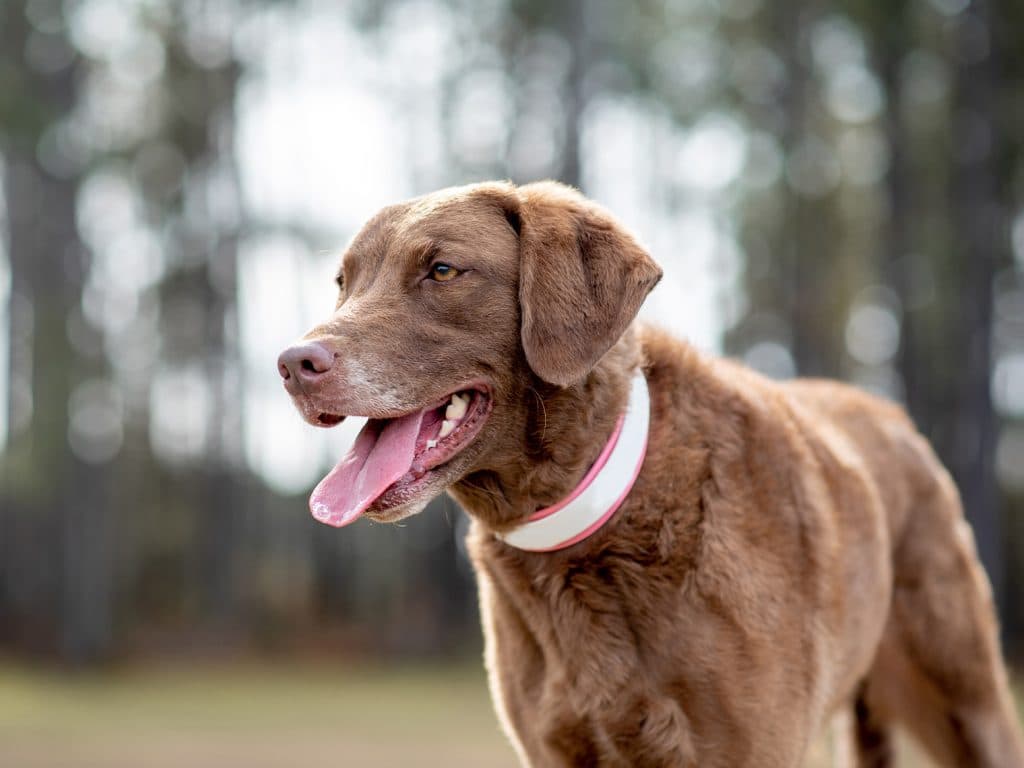
Tanya Consaul Photography / Shutterstock
The Chesapeake Bay Retriever is a hunting dog who once specialized in waterfowl retrieval in the Chesapeake Bay area (though they could probably be convinced to do it elsewhere, if you need waterfowl retrieval in your neighborhood). These large-breed dogs weigh around 80 pounds; they are sturdy guys with short, thick coats that are usually brown or tan.
This breed is considered independent and confident, with strong hunting instincts and a love of the water. They enjoy swimming, playing fetch, and other activities that involve retrieving — it’s in the name! They also love training focused on obedience, agility, and other challenges. Keep them busy and well-brushed, and you’ll have a healthy, happy friend.
Height: 21 to 26 inches
Weight: 48 to 87 pounds
Browse for Chesapeake Bay Retrievers (and their mixes) for adoption

Studio Canvia / Stocksy
The Dalmatian has a spotted black and white coat so famously beautiful that a whole movie was made about someone wanting to make Dalmatian puppies into a coat. Dalmatians are also known as the firehouse mascot of choice, and they once had a place in culture as a circus performer. Clearly, this is a breed with a lot of mythology.
While the Dalmatian is not the largest dog breed (in fact, they tend to run more medium-sized), some Dalmatians can get as heavy as 75 pounds. They are outgoing, playful, and good with families, including kids. Exercise-wise, Dalmatians love to run, and need lots of outdoor stimulation. That beautiful coat sheds heavily, so expect to put in the time to groom this famous breed.
Height: 23 to 24 inches
Weight: 45 to 70 pounds
Browse for Dalmatians (and their mixes) for adoption

Jasmina007 / iStock
The Bernese Mountain Dog has a distinctive black, white, and rust-red tri-colored coat and was originally bred in Switzerland. They’re gentle and good at climbing hills, which is very useful for a family on a mountainside if you know one. These hefty pups weigh around 110 pounds and are pretty easy-going but will bark to alert you of anything they find suspicious.
Though these giant-breed dogs are playful, their exercise needs are fairly moderate, and they enjoy a good hang-out as much as a walk. However, they don’t love small spaces and would benefit from a yard. That yard better be someplace cool because they can get pretty miserable in hot weather and need shade to cool off.
Height: 23 to 26 inches
Weight: 70 to 123 pounds
Browse for Bernese Mountain Dogs (and their mixes) for adoption

Kara Riley / Stocksy
German Wirehaired Pointers are known for their hunting skills, athleticism, and being friendly. Built for endurance, they’re simultaneously lean and swole, and they’re smart and friendly, but do have a high prey drive and will almost certainly chase small animals without some training teaching them not to.
The German Wirehaired Pointer is a medium-large dog breed weighing 60 to 70 pounds and needs lots of exercise. They’re especially known as runners and enjoy hiking, swimming, hunting, and tracking. Give them lots of attention, activity, and space to roam, and they’ll do great.
Height: 22 to 26 inches
Weight: 42 to 82 pounds
Browse for German Wirehaired Pointers (and their mixes) for adoption

shargoo / Pixabay
The Beauceron is a versatile working dog. With a robust physique, Beaucerons excel in various roles, from herding to protection. Their focused demeanor and strong bond with their people make them an excellent choice for experienced handlers seeking a devoted and capable pal.
Height: 24 to 28 inches
Weight: 57 to 88 pounds
Browse for Beaucerons (and their mixes) for adoption

Sebastiaan-Wirestock / AdobeStock
Sporting a water-resistant coat that sets them apart, the Curly-Coated Retriever possesses a unique blend of playful exuberance and keen intelligence. Their friendly disposition and boundless energy make them a perfect match for active families and individuals seeking a loyal and dynamic pet.
Height: 25 to 27 inches
Weight: 58 to 90 pounds
Browse for Curly-Coated Retrievers (and their mixes) for adoption

encierro / AdobeStock
With their distinctive white coat and a history rooted in hunting and protection, Dogo Argentinos possess a commanding presence. Known for their protective nature and fierce devotion to their families, Dogo Argentinos make excellent guardians and companions.
Height: 24 to 27 inches
Weight: 75 to 100 pounds

Samantha Gehrmann / Stocksy
The Golden Retriever shines as a friendly and intelligent companion. Goldens have lustrous golden coats and warm, affectionate natures. Renowned for their loyalty and gentle temperament, Golden Retrievers excel as family pets and service dogs alike.
Height: 20 to 24 inches
Weight: 46 to 80 pounds

Benjamin Wedemeyer / Unsplash
The Hovawart is a large breed who thrives with an active family. With a strong protective instinct and a balanced temperament, they excel as devoted guardians and intelligent family pets.
Height: 22 to 27 inches
Weight: 55 to 88 pounds
Browse for Hovawarts (and their mixes) for adoption

Alex / AdobeStock
The Irish Setter stands out with their captivating auburn coat and friendly disposition. With seemingly boundless energy and playful temperament, these pups are the perfect match for active individuals and families.
Height: 25 to 26 inches
Weight: 48 to 88 pounds
Browse for Irish Setters (and their mixes) for adoption

Gillian Vann / Stocksy
The Rhodesian Ridgeback rocks a unique ridge of hair along their back, which flaunts a serious vibe. These pups were bred for hunting, giving them strong protective instincts, lots of confidence, and endurance to spare.
Height: 24 to 26 inches
Weight: 59 to 97 pounds
Browse for Rhodesian Ridgebacks (and their mixes) for adoption
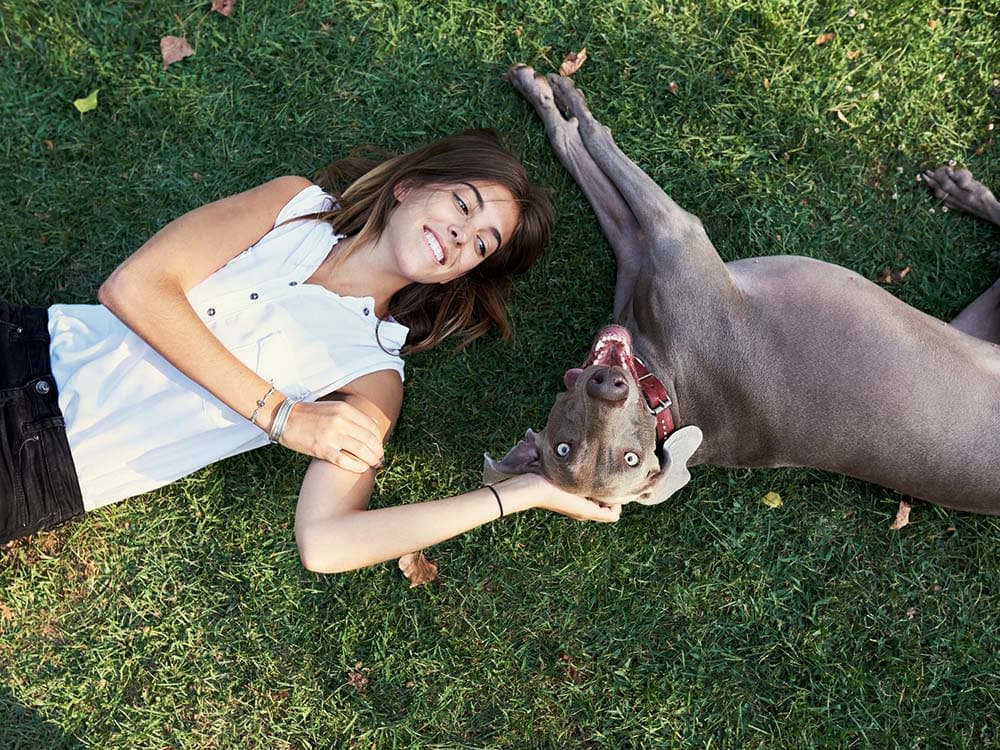
Guille Faingold / Stocksy
Weimaraners are a striking breed with a unique silver-gray coat and a sturdy build. They are highly energetic and intelligent, making them an ideal choice for active individuals and families seeking a fun-loving pup for outdoor adventures.
Height: 22 to 27 inches
Weight: 54 to 97 pounds
Browse for Weimaraners (and their mixes) for adoption

Mary Swift / AdobeStock
The Bluetick Coonhound boasts a distinct coat pattern that makes them instantly recognizable. Originating as skilled hunters, they offer a mix of determination and affection to active families who enjoy outdoor adventure and companionship.
Height: 21 to 27 inches
Weight: 50 to 78 pounds
Browse for Bluetick Coonhounds (and their mixes) for adoption

Marianna / AdobeStock
The American Bulldog is built like a tank. With a history rooted in hard work, these pups are like your best buddy and bodyguard rolled into one. They have hearts of gold and offer their families unwavering affection and watchful protection. Some American Bulldogs have the temperament to become therapy dogs, providing comfort and companionship to people in hospitals, nursing homes, and other settings.
Height: 20 to 28 inches
Weight: 62 to 118 pounds

Guille Faingold / Stocksy
Bubbling with energy and affection, it’s no wonder that the Labrador Retriever has consistently ranked as one of the most popular dog breeds. These large pups have a friendly demeanor and trademark wagging tails.
Height: 21 to 24 inches
Weight: 49 to 77 pounds
Browse for Labrador Retrievers (and their mixes) for adoption
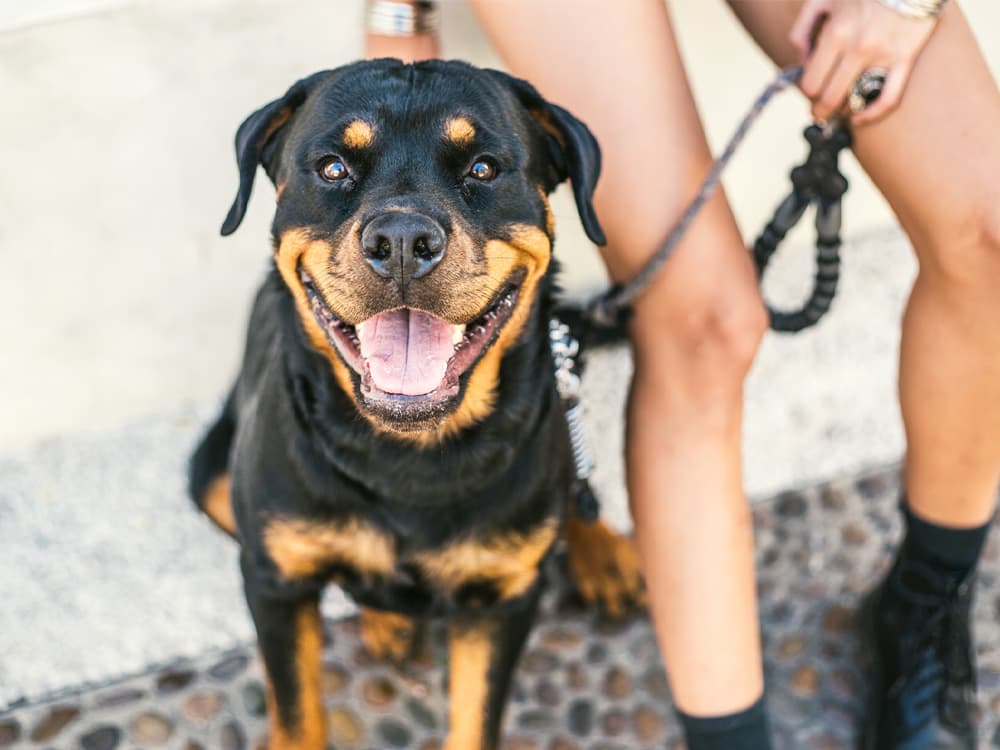
Jovo Jovanovic / Stocksy
Rottweilers are the ultimate sidekicks. This stocky breed strikes a balance between fierce protector and loyal lap-dog, sticking to their families like glue. Their trustworthy nature and affectionate demeanor make them perfect companions for active families.
Height: 23 to 27 inches
Weight: 72 to 132 pounds
Browse for Rottweilers (and their mixes) for adoption

Oleksii Syrotkin / Stocksy
Australian Shepherds are like your all-in-one adventure buddies, ready for anything from a game of fetch to a hiking escapade. They make exceptional companions for active individuals and families ready for a challenge.
Height: 18 to 23 inches
Weight: 38 to 66 pounds
Browse for Australian Shepherds (and their mixes) for adoption

Jeannette1980 / Pixabay
Borzois, similar to their Greyhound relatives, are elegant and swift pups. However, these large Russian hunting dogs have stunning, lengthy fur that provides insulation to keep them cozy and warm.
Height: 27 to 29 inches
Weight: 59 to 111 pounds
Browse for Borzois (and their mixes) for adoption

Marija Kovac / Stocksy
Standard Poodles are known for being super smart and highly trainable, which makes them great pets and even better competitive dogs for canine sports. Poodles come in a wide range of colors, including black, white, apricot, cream, blue, gray, silver, brown, red, sable, parti (a combination of white with other solid colors), and phantom (specific markings).
Height: 14 to 24 inches
Weight: 45 to 75 pounds
Browse for Poodles (and their mixes) for adoption
Large-breed dogs aren’t for everyone because most have specific needs to maintain good health and well-being. If you’re considering adopting a large breed dog, here are a few things to consider.
Space is probably the most obvious issue: Some large breed dogs are fine with a moderate exercise routine, but even they prefer more square footage to feel comfortable. Small apartments aren’t a great choice for them, or you. Preferably, a large breed would live in a house with a yard they can play in.
For diet, large breeds often have a slower metabolism and can be prone to obesity; they need high-quality food to keep them at a healthy weight, which a vet can help you choose. They also eat a lot, so be prepared to stock up on the kibble, which will cost you a good chunk of change each week.
Most large breeds need more exercise than smaller dogs and often have a lot of energy. If you don’t have the time or physical fortitude to walk, run, or play with them, you might be setting yourself up for disaster. An unhappy, unstimulated, and under-exercised dog can get destructive, and a BIG dog can quickly destroy a whole lot.
As a rule of thumb, the sooner you train your dog, the better — especially with larger dogs who can cause more destruction in your home. Consult our guides for common issues such as chewing, barking or separation anxiety when they’re alone, and not jumping on folks. You may be able to handle training yourself, but if you’d like (or need) help, be sure to budget for the cost of reaching out to your vet or a behaviorist.
Whether introducing your new dog to your existing dog and family, or arranging play-dates with other dogs (and humans!), early socialization is an important step to making your pup comfortable around other pets and people. This may be done gradually by yourself, but many pet parents appreciate services such as doggy daycare to facilitate, and speed along, this process. This may incur costs, while also requiring patience and positive reinforcement.
One downside to their large size is the health issues associated with heavier weights and a bigger build.
Large breeds are often prone to joint problems like hip dysplasia or arthritis, so protect their joint health via a diet that supports joints combined with strengthening exercise that doesn’t put excessive stress on their knees and hips.
Large breed dogs have a higher risk of developing bloat, which is a life-threatening condition that occurs when the stomach twists and traps gas inside. Be aware of the signs and causes of bloat for your pup.
Large breeds are also more susceptible to cardiac issues such as dilated cardiomyopathy, a condition that affects the heart’s ability to pump blood effectively, and they may have a higher risk of developing certain types of cancer.
Sadly, the life expectancy of a large-breed dog is shorter on average compared to smaller dogs. However, that can really vary from breed to breed, and with proper care and awareness of potential health issues, large-breed dogs can live long and healthy lives.
Many large dog breeds are available for adoption at local shelters and rescue groups across the United States. Start your search at adoptapet.com
Most large dogs will shed, but some less than others. If you’re hoping for a low-shedding dog, you may want to look into the Rhodesian Ridgeback, American Staffordshire Terrier, Boxer, Greyhound, American Bulldog, and Standard Poodle.
According to the American Kennel Society, American Bulldogs, Collies, and Golden Retrievers are large-dog breeds that are good with cats. As for other breeds, most (but not all) can be trained to tolerate cats. So always do your research (and even consult a vet) before introducing a dog to a cat.
Mastiffs are reportedly the largest domestic, household dog breed, with males weighing up to 230 pounds and females up to 170 pounds. Despite their imposing stature, they’re known for being sweet, patient dogs who are good with kids and other dogs.
The healthiest large-dog breeds with longer life expectancy include the Collie (up to 14 years), Australian Shepherd (up to 15 years), as well as mixed-breed dogs. As with humans, lifespan will differ by individual dog — and small dogs will tend to have longer lives.
Some of the friendliest large-breed dogs are said to be Retrievers (Curly-Coated Retrievers, Golden Retrievers, Labrador Retrievers), Airedale Terriers, German Wirehaired Pointers, and Irish Setters. Training can also influence any large dog’s reaction towards you, children, and other dogs.
Purebred Dogs May Face Health Challenges
WA State Vet Med Hypothyroidism in Dogs
Your Big Dog May Be More Likely to Develop These Health Problems
Why Do Small Dogs Live Longer Than Big Dogs

Kelly Villa is a freelance writer and contributor to various pet publications.

Behavior & Training

Adoption Advice

Adoption Advice

Breed Info
Meet the bully breeds who will melt your heart.
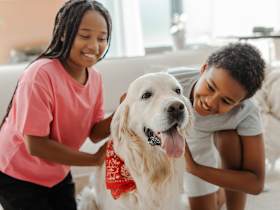
Breed Info

Breed Info
One of the joys of adopting a dog is sinking your hands into their fluff, and it’s totally okay to admit that.

Breed Info
Here’s why ear cropping started and why it’s not so good for dogs.

Breed Info
Are you thinking of adopting a dog that is easy to care for? Here is what it takes to keep them happy and healthy.

Breed Info
Plus, five things to know before adding one of these mixed-breed dogs to your family.